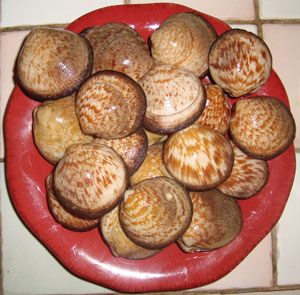Clams Ahoy!
Everything you always wanted to know about Clams but were afraid to ask!!
Amandes de Mer - Dog Cockles
A Wonderful Clam I encountered in the South of France
It wasn't a clam finding mission, but I encountered the tasty, pretty and delightful Amandes de Mer clam in France, sometimes just abbreviated to Amandes on seafood menus and seafood shops. The British call them "dog cockles," although they are not closely related to cockles, which shows that they do not have a way with words! They are also called the European bittersweet (also the name of a plant), and their scientific name is Glycymeris glycymeris.
The name "Amandes de Mer" literally means almond of the sea, and although I didn't know this when eating them and I didn't immediately jump up and say "These clams taste like almonds," they are sweet clams and yes, I can see that they have a bit of an almond flavor. The Spanish agree with the French on the flavor apparently as they call them "almendra de mar" which in Spanish is also almond of the sea.
They
have a smooth shell and colors can vary, commonly orange, brown, and/or a
light purple, and the coloration can be uniform or concentric yet irregular
with zigzags on an off
 white background. Habit is shelly gravel, similar to
the European surf clam, Spisula solida, up to 300+ feet deep.
white background. Habit is shelly gravel, similar to
the European surf clam, Spisula solida, up to 300+ feet deep.
My clams were about 2 to 2.5 inches across, up to almost 6.5 cm, which is their maximum size. We bought them, along with some European Cockles, and at large "Sams Club" or "BJs" type outlet which had a large seafood selection. We were near Orleans, France, maybe 100 miles South of Paris and not near the ocean, and the clams were not super fresh at all but were OK. We had to discard many as they did not open upon cooking.
They are widely available throughout much of Europe, in part because they are farmed in Brittany and Normandy as well as naturally harvested. They are a by catch of the European surf clam (Spisula solida), and less expensive. They get tough if overcooked, but in our taste tests were just fine. The European Food Research and Technology reports "low commercial value because its texture is too tough after cooking" and you can see their paper "Tenderisation of the dog cockle (Glycymeris glycymeris) meat by polyphosphates" here.
My take away is that they are a fine clam for eating fresh, however can use some treatment if preserved by canning. Next time I see them in a market, or on a menu whether listed as amandes de mer, just amandes, or dog cockles, I'm going to order them again!
And just for the record, I had them with cockles on pasta in an Italian dish my friend Pierre cooked.
 Hi,
we are Ted and John, just two guys who love Clams and other seafood.
Hi,
we are Ted and John, just two guys who love Clams and other seafood.